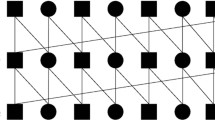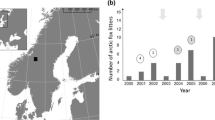Abstract
Previous work on the Glanville fritillary butterfly (Melitaea cinxia) shows substantial inbreeding depression in both of our two study regions, Finland and southern France. The influence of inbreeding depression on population dynamics should depend on the strength of inbreeding avoidance. We conducted mate choice experiments to ascertain whether and to what extent butterflies avoid mating with their sibs. Experiments with similar design were done in the laboratory with Finnish butterflies and in the field with French butterflies. Each female was given a choice of mates with equal opportunity to mate with a sib or with a non-sib. In neither experiment was there a trend towards avoidance of sib mating. 95% confidence intervals for the proportion of non-sib matings were 12–62% in the laboratory experiment and 28–69% in the field experiment. Any preference for non-sibs must be slight, and can provisionally be ignored in modelling the dynamics of M. cinxia populations.
Similar content being viewed by others
References
Ball, S.J., Adams, M., Possingham, H.P. and Keller, M.A. (2000) The genetic contribution of single male immigrants to small, inbred populations: a laboratory study using Drosophila melanogaster. Heredity 84, 677–684.
Bateson, P. (1978) Sexual imprinting and optimal outbreeding. Nature 273, 659–660.
Bateson, P. (1982) Preferences for cousins in Japanese quail. Nature 295, 236–237.
Cockburn, A., Scott, M.P. and Scotts, D.J. (1985) Inbreeding avoidance and male-biased natal dispersal in Antechinus spp. (Marsupialia: Dasyuridae). Anim. Behav. 33, 908–915.
Colegrave, N. and Ruxton, G.D. (2003) Confidence intervals are a more useful complement to nonsignificant tests than are power calculations. Behav. Ecol. 14, 446–447.
Crawley, M.J. (1997) Sex. In M.J. Crawley (ed.) Plant Ecology. 2nd edn. Blackwell Science, pp. 156–213.
Dobson, F.S., Chesser, R.K., Hoogland, J.L., Sugg, D.W. and Foltz, D.W. (1997) Do black-tailed prairie dogs minimize inbreeding? Evolution 51, 970–978.
Futuyma, D.J. (1997) Evolutionary Biology. 3rd edn. Sinauer Associates, Sunderland, Massachu-setts.
Gibbs, H.L. and Grant, P.R. (1989) Inbreeding in Darwin's Medium Ground Finches (Geospiza fortis). Evolution 43, 1273–1284.
Haikola, S., Fortelius, W., O'Hara, R.B., Kuussaari,M., Wahlberg, N., Saccheri, I.J., Singer, M.C. and Hanski, I. (2001) Inbreeding depression and the maintenance of genetic load in Melitaea cinxia metapopulations. Conserv. Genet. 2, 325–335.
Hanski, I. (1999) Metapopulation Ecology. Oxford University Press, Oxford.
Hanski, I., Pakkala, T., Kuussaari, M. and Lei, G. (1995a) Metapopulation persistence of an endangered butterfly in a fragmented landscape. Oikos 72, 21–28.
Hanski, I., Pöyry, J., Pakkala, T. and Kuussaari, M. (1995b) Multiple equilibria in metapopulation dynamics. Nature 377, 618–621.
Hanski, I. and Singer, M.C. (2001) Extinction-colonization dynamics and host-plant choice in butterfly metapopulations. Am. Nat. 158, 341–353.
Hedrick, P.W. and Kalinowski, S.T. (2000) Inbreeding depression in conservation biology. Ann. Rev. Ecol. Syst. 31, 139–162.
Hoogland, J.L. (1982) Prairie dogs avoid extreme inbreeding. Science 215, 1639–1641.
Ingvarsson, P.K. (2001) Restoration of genetic variation lost — the genetic rescue hypothesis. Trends Ecol. Evol. 16, 62–63.
Joron, M. and Brakefield, P.M. (2003) Captivity masks inbreeding effects on male mating success in butterflies. Nature 424, 191–194.
Keane, B. (1990) The effect of relatedness on reproductive success and mate choice in the white-footed mouse, Peromyscus leucopus. Anim. Behav. 39, 264–273.
Keane, B., Creel, S.R. and Waser, P.M. (1996) No evidence of inbreeding avoidance or inbreeding depression in a social carnivore. Behav. Ecol. 7, 480–489.
Keller, L. and Passera, L. (1993) Incest avoidance, fluctuating asymmetry, and the consequences of inbreeding in Iridomyrmex humilis, an ant with multiple queen colonies. Behav. Ecol. Sociobiol. 33, 191–199.
Koenig, W.D. and Pitelka, F.A. (1979) Relatedness and inbreeding avoidance: counterploys in the communally nesting acorn woodpecker. Science 206, 1103–1105.
Krackow, S. and Matuschak, B. (1991) Mate choice for non-siblings in wild house mice: evidence from a choice test and a reproductive test. Ethology 88, 99–108.
Kuussaari, M. (1998) Biology of the Glanville fritillary butterfly (Melitaea cinxia). PhD thesis, University of Helsinki, Finland.
Kuussaari, M., Nieminen, M. and Hanski, I. (1996) An experimental study of migration in the Glanville fritillary butterfly Melitaea cinxia. J. Anim. Ecol. 65, 791–801.
Kuussaari, M., Saccheri, I., Camara, M. and Hanski, I. (1998) Allee effect and population dynamics in the Glanville fritillary butterfly. Oikos 82, 384–392.
Markow, T.A. (1997) Assortative fertilization in Drosophila. Proc. Natl. Acad. Sci. USA 94, 7756–7760.
Nieminen, M., Singer, M.C., Fortelius, W., Schöps, K. and Hanski, I (2001) Experimental confirmation that inbreeding depression increases extinction risk in butterfly populations. Am. Nat. 157, 237–244.
Olsson, M., Shine, R., Madsen, T., Gullberg, A. and Tegelström, H. (1996) Sperm selection by females. Nature 383, 585.
Palo, J., Varvio, S.-L., Hanski, I. and Väinölä, R. (1995) Developing microsatellite markers for insect population structure: complex variation in a checkerspot butterfly. Hereditas 123, 295–300.
Peacock, M.M. and Smith, A.T. (1997) Nonrandom mating in pikas Ochotona princeps: evidence for inbreeding between individuals of intermediate relatedness. Mol. Ecol. 6, 801–811.
Richards, C.M. (2000) Inbreeding depression and genetic rescue in a plant metapopulation. Am. Nat. 155, 383–394.
Saccheri, I., Kuussaari, M., Kankare, M., Vikman, P., Fortelius, W. and Hanski, I. (1998) Inbreeding and extinction in a butterfly metapopulation. Nature 392, 491–494.
Simmons, L.W. (1991) Female choice and the relatedness of mates in the field cricket, Gryllus bimaculatus. Anim. Behav. 41, 493–501.
Thrall, P.H., Richards, C.M., McCauley, D.E. and Antonovics, J. (1998) Metapopulation collapse: the consequences of limited gene-flow in spatially structured populations. In J. Bascompte and R.V. Solé (eds.) Modeling spatiotemporal dynamics in ecology. Springer-Verlag, Berlin, pp. 83–104.
Author information
Authors and Affiliations
Corresponding author
Rights and permissions
About this article
Cite this article
Haikola, S., Singer, M.C. & Pen, I. Has inbreeding depression led to avoidance of sib mating in the Glanville fritillary butterfly (Melitaea cinxia)?. Evolutionary Ecology 18, 113–120 (2004). https://doi.org/10.1023/B:EVEC.0000021062.97769.66
Issue Date:
DOI: https://doi.org/10.1023/B:EVEC.0000021062.97769.66




